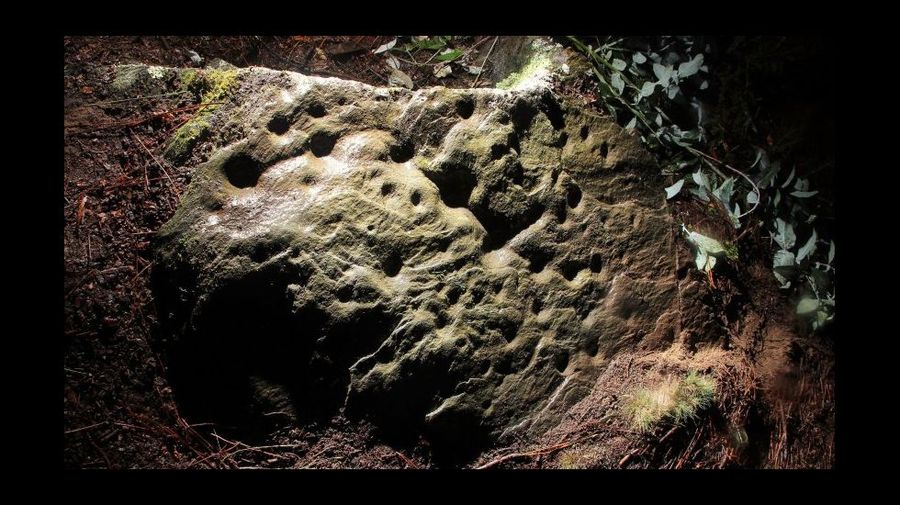 |
| 1/6 |
El conjunto de pinturas rupestres de Peña Piñera, en Sésamo, avanza lentamente hacia a su desaparición total si ninguna administración lo remedia. De nada han servido las llamadas de atención municipales de Vega de Espinareda y una tímida actuación hace tiempo en la zona por parte de Patrimoni...
Descubren en Touro un petroglifo con cuarenta símbolos / Link 2
 |
| 1/2 |
La riqueza prehistórica del eje que forman Santiago, Ames y Teo no es única en su entorno. Así lo ha demostrado el colectivo cultural A Rula en su colaboración con el Concello de Touro para realizar un trabajo que les ha permitido descubrir el primer petroglifo del municipio, entre las parroquias de Circes y Calvos de Socamiño...
---
Ancient henge discovered in Yorkshire - Yorkshire Post / Link 2
 |
| Aerial picture of the excavations at Little Catwick Quarry |
THOUSANDS of years ago it would have stood proud on the horizon, a striking monument which could be seen for miles.
The circular monument lay hidden for centuries under farmland, its existence only hinted at in crop marks, spotted in aerial surveys.
But over the past three months archeologists have been hard at work bringing to light what they believe could be East Yorkshire’s first Woodhenge - as in Stonehenge without the stone - at Little Catwick Quarry near Hornsea. And it could have been used for ritual cremation - or even a sauna.
Built at least 4,000 years ago in the late Neolithic to Bronze Age, it was constructed out of a series of wooden posts.
Later an encircling ditch and bank was added with two opposing entrances, one facing north west, the other south east... (Video)
Stonehenge 100 | English Heritage
This year is an important anniversary for Stonehenge. A hundred years ago, in 1918, local barrister Cecil Chubb and his wife Mary gifted it to the nation. This public spirited decision marked a turning point in the history of Stonehenge and its fortunes...
Vídeo. Stonehenge - 100 Years of Care and Conservation - English Heritage. Ver en PaleoVídeos > L.R.2.15 nº 5.
Study may shed new light on dispersal of early modern humans | Popular Archaeology
Results from the analysis of stone tools from Skhul Cave may help reveal a complex picture of how, when and where early modern humans left Africa.
A recent study of lithic artifacts recovered decades ago from the Mount Carmel (in Israel) Skhul Cave suggests, according to the study authors, that the occupation of the Levant by early modern humans during the Pleistocene was not as simple and straight-forward as the traditionally accepted paradigm has depicted...
Toronto woman's 80-year-old discovery turns out to be an ancient Indigenous arrowhead | CBC Radio
Stone tools dating back to 15,000 years found in Mumbai | Hindustan Times
The microliths, or minute flint stone tools, were found on a hill next to Manori beach, which experts believe could have been a possible factory site for such implements.
Researchers said the findings were important in tracing Mumbai’s early days and the kind of habitation the islands had in the Mesolithic era...
Neolithic artefacts discovered in SW China - The Archaeology News Network / Link 2
A number of cultural relics dating back up to 5,000 years have been unearthed in southwest China's Sichuan Province.
The excavation started in October and led to 122 major discoveries including 15 structural remains, 93 ash pits and eight tombs, with a total coverage of 800 square meters, at the Guijiabao relic sites in Yanyuan County, the cultural relics and archeology research institute of Chengdu said....
Más noticias / More news
Actualización. Un estudio arroja nueva luz sobre la dispersión de los primeros humanos modernos en el Levante Un reciente estudio sobre artefactos líticos recuperados hace décadas en la Cueva Skhul, en el Monte Carmelo (Israel), sugiere, según sus autores, que la ocupación del Levante por los primeros humanos modernos durante el Pleistoceno no fue tan sencilla y directa como el paradigma, tradicionalmente aceptado, la ha presentado...
Toronto woman's 80-year-old discovery turns out to be an ancient Indigenous arrowhead | CBC Radio
Stone tools dating back to 15,000 years found in Mumbai | Hindustan Times
The microliths, or minute flint stone tools, were found on a hill next to Manori beach, which experts believe could have been a possible factory site for such implements.
Researchers said the findings were important in tracing Mumbai’s early days and the kind of habitation the islands had in the Mesolithic era...
Neolithic artefacts discovered in SW China - The Archaeology News Network / Link 2
A number of cultural relics dating back up to 5,000 years have been unearthed in southwest China's Sichuan Province.
The excavation started in October and led to 122 major discoveries including 15 structural remains, 93 ash pits and eight tombs, with a total coverage of 800 square meters, at the Guijiabao relic sites in Yanyuan County, the cultural relics and archeology research institute of Chengdu said....
Más noticias / More news
Actualización. Un estudio arroja nueva luz sobre la dispersión de los primeros humanos modernos en el Levante Un reciente estudio sobre artefactos líticos recuperados hace décadas en la Cueva Skhul, en el Monte Carmelo (Israel), sugiere, según sus autores, que la ocupación del Levante por los primeros humanos modernos durante el Pleistoceno no fue tan sencilla y directa como el paradigma, tradicionalmente aceptado, la ha presentado...








No hay comentarios:
Publicar un comentario